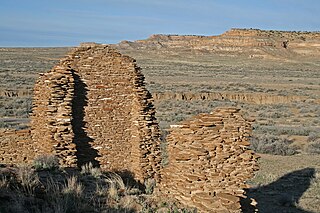Kin Nahasbas is a Chacoan Anasazi great house and archaeological site located in Chaco Canyon, 25 miles southwest of Nageezi, New Mexico, United States. Built in either the 9th or 10th centuries, it was major pueblo located slightly north of the Una Vida complex, which is positioned at the foot of the north mesa. Limited excavation has been conducted in this area. [1] The ruins are now protected within the borders of Chaco Culture National Historical Park.

Nageezi is a census-designated place (CDP) in San Juan County, New Mexico, United States. The population was 296 at the 2000 census. It is part of the Farmington Metropolitan Statistical Area.

The United States of America (USA), commonly known as the United States or America, is a country composed of 50 states, a federal district, five major self-governing territories, and various possessions. At 3.8 million square miles, the United States is the world's third or fourth largest country by total area and is slightly smaller than the entire continent of Europe's 3.9 million square miles. With a population of over 327 million people, the U.S. is the third most populous country. The capital is Washington, D.C., and the largest city by population is New York City. Forty-eight states and the capital's federal district are contiguous in North America between Canada and Mexico. The State of Alaska is in the northwest corner of North America, bordered by Canada to the east and across the Bering Strait from Russia to the west. The State of Hawaii is an archipelago in the mid-Pacific Ocean. The U.S. territories are scattered about the Pacific Ocean and the Caribbean Sea, stretching across nine official time zones. The extremely diverse geography, climate, and wildlife of the United States make it one of the world's 17 megadiverse countries.

Una Vida is an archaeological site located in Chaco Canyon, San Juan County, New Mexico, United States. According to tree rings surrounding the site, its construction began around 800 AD, at the same time as Pueblo Bonito, and it is one of the three earliest Chacoan Ancestral Puebloan great houses. Comprising at least two stories and 160 rooms, it shares an arc or D-shaped design with its contemporaries, Peñasco Blanco and Pueblo Bonito, but has a unique "dog leg" addition made necessary by topography. It is located in one of the canyon's major side drainages, near Gallo Wash, and was massively expanded after 930 AD.
Archeologists Lekson, Windes and McKenna [2] place the construction of Kin Nahasbas (kin nahas bas) in the late 9th century along with early construction work on Pueblo Bonito, Peñasco Blanco, Una Vida, the Padilla Well Great House, the East Community, Pueblo Pintado and Casa del Rio at the extreme western end of the Chaco core.

Pueblo Bonito is the largest and best-known great house in Chaco Culture National Historical Park, northern New Mexico. It was built by the Ancestral Puebloans who occupied the structure between AD 828 and 1126.

Peñasco Blanco is a Chacoan Ancestral Puebloan great house and notable archaeological site located in Chaco Canyon, a canyon in San Juan County, New Mexico, United States. The pueblo consists of an arc-shaped room block, part of an oval enclosing a plaza and great kiva, along with two great kivas outside the great house. The pueblo was built atop the canyon's southern rim to the northwest of the great houses in the main section of the canyon. The building was constructed in five distinct stages between AD 900 and 1125. A cliff painting nearby may record the sighting of a supernova on July 5, 1054 AD.
Unlike Pueblo Bonito, Una Vida and other Great House ruins that can be seen in the Chaco park today, Nahasbas probably was not occupied/maintained into the next century. Today the National Park Service does not have the Nahasbas House site open for visitors. It has not been excavated/stabilized and there are no interesting ruins to see. The late 9th century when Kin Nahabas was built is the transition period between Pueblo I and II cultures. In Chaco the population of people living in small houses grew enormously. This growth was probably supported by migrating peoples drawn to Chaco from the great Pueblo I communities in the northern San Juan (river) region. The period provided favorable rains for farming maize in Chaco canyon and on the mesas that could sustain a growing "urban" Chaco population.













